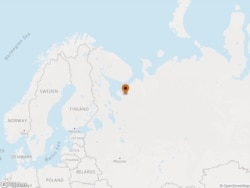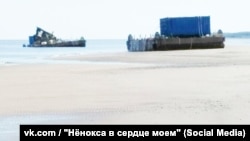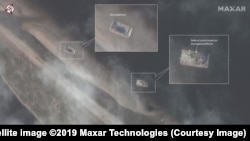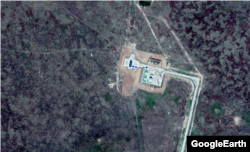The explosion at a Russian naval test range earlier this month that killed at least five people and sent out a plume of radiation may have occurred when specialists tried to salvage a sunken missile from the White Sea floor.
Documents, photographs, satellite imagery, and other open-source materials reviewed by RFE/RL point strongly to an accident -- most likely underwater, or just near the surface -- as the cause of the August 8 blast in Nyonoksa, where Soviet and Russian military planners have conducted missile tests for decades.
In the days after the mishap, Russian civilian and military authorities gave conflicting information as to what exactly occurred, how many casualties there were, and where a recorded spike in radiation came from, and whether it was dangerous. It also sent intelligence analysts from Washington to Brussels to Oslo scrambling to figure out what happened.
President Vladimir Putin has said the test involved a new weapons system.
The Defense Ministry revealed the incident on the day it happened, saying two people had been killed, but gave no other details. Two days later, the state-run nuclear agency Rosatom revealed that five of its employees had been killed while they were conducting "technical-engineering oversight" of a test of "radioactive isotope fuel for a liquid-fueled rocket engine."
On August 11, managers at the state research institute where the killed engineers were employed revealed in a video interview that the researchers had been investigating, among other things, "the creation of small-scale sources of energy using radioactive fissile materials."
The institute where the men worked is Russia's premier facility for military nuclear research, known by its acronym VNIIEF and located in the closed city of Sarov.
Meanwhile, monitoring stations in the nearby shipbuilding port of Severodvinsk reported a brief spike in radiation levels in the hours after the explosion, but emphasized that there was no danger to public health.
On August 26, Russia's federal weather agency said its sensors had detected several radioactive isotopes, including those that independent experts said were associated with a nuclear reaction, or a "fissile event."
'This Is What Death Looks Like'
Among the photographs and videos obtained by RFE/RL and first published on August 22 is one that shows two pontoon platforms floating close to the shoreline just west of the main Nyonoksa range site.
On each platform are two 6-meter, blue shipping containers, the kind that often appear in Defense Ministry promotional materials about missile launches.
The location of the containers matches up with satellite imagery obtained by RFE/RL in the days shortly after the explosion that also shows two objects floating close to shore in a similar position.
It matches up with another image obtained exclusively by RFE/RL that shows a blue container onshore at the Nyonoksa test site in October 2018.
And it matches up with a Google Maps image from 2019 of Kasputin Yar, a test range in southern Russia where analysts say a nuclear-powered cruise missile called the Burevestnik may have been tested in the past.
The blue containers are also used by a St. Petersburg shipping company called Ekomet-C, which advertises them as suitable for the "storage and transport of solid radioactive waste."
Several of the photographs of the platforms were initially posted on the Russian social-media site VK, on a closed chat group titled Nyonoksa In My Heart with the caption: "This is what death looks like."
Identical pontoon platforms also appear in photographs showing the wharves at the Sevmash shipyard in Severodvinsk, 30 kilometers east of Nyonoksa. Sevmash is one of Russia's largest shipyards and the country's only builder of nuclear submarines.
The platforms, whose current locations are unclear, are widely believed to be irradiated, along with other debris that washed up on the Dvinsk Bay shores after the blast. That prompted military officials to warn local residents not to approach anything washing up on the shore.
Videos obtained by RFE/RL show Naval Captain First Rank Vladimir Bosy, the commander of the Nyonoksa range, meeting with local residents on August 12 to warn them about irradiated flotsam.
Serebryanka And Zvyozdochka
Satellite images and websites that track global shipping traffic have also identified the presence of a Rosatom ship called the Serebryanka that was in the Dvinsk Bay in the days leading up to the August 8 explosion. The ship is known for its role in transporting nuclear waste for the atomic energy company.
The ship was located 4 kilometers from Nyonoksa on the day of the blast and was tracked leaving the region and returning to its home port of Murmansk on August 9.
Another ship also appears in a satellite image dated August 13: a special purpose rescue and recovery ship known as the Zvyozdochka. Equipped with two heavy-lift cranes positioned on its aft, the ship also has two deepwater, unmanned submersibles believed to be used primarily for salvage and recovery operations.
In an online Russian chat room called sanatatur.ru, used by fishermen in the Arkhangelsk region, where Nyonoksa is located, at least two users posted messages dated August 9 saying that there had been an operation the previous day to recover what they called a "warhead" that had been lost last year at the Nyonoksa range.
One of the users, who did not respond to inquiries from RFE/RL, also said one of the ships in the vicinity of the blast had suffered a hole in its hull. Another said he had been within 4 kilometers of the test site on the morning of August 8 and witnessed a 100-meter column of water that burst into the air.
Another indication that the explosion first occurred underwater or near the water's surface came in the presentation by Navy officer Bosy before the Nyonoksa villagers.
"On August 8, people got onto the pontoon, and then everything under the pontoon exploded," he said.
Burevestnik
In the days after the explosion, one of the most frequently cited theories for the cause was a failed test of a nuclear-powered cruise missile known in Russia as the Burevestnik and under NATO standards as Skyfall. The missile, which Putin boasted about during a nationally televised speech in March 2018, has reportedly suffered several failures during testing, and there has been at least one previous attempt to recover a missile lost at sea.

But evidence that emerged later, including from the Rosatom statement, has undermined that theory, leading analysts to focus on other explanations.
The findings announced on August 26 by Rosgidromet that isotopes associated with a nuclear reaction were released have further deepened analysts' concerns that Russian engineers may have inadvertently set off a small, potentially disastrous fissile reaction. One U.S.-based analyst called it "inadvertent criticality."
No NOTAM
Another piece of evidence that suggests the August 8 blast was not the result of a missile test was the absence of an aviation warning from Russian authorities in the vicinity of Nyonoksa.
Aviation authorities -- in Russia, the United States, and many countries -- typically issue a notice to pilots when a potential hazard is anticipated in a certain location. Russia nearly always issues such notices -- known as NOTAMs -- before major missile tests, including the recent one of a submarine-launched ballistic missile from the Barents Sea.
A NOTAM was issued for the Nyonoksa vicinity last October when a similar test was reported, a test that included the presence of the Rosatom-owned ship, the Serebryanka. But no NOTAM was issued in the days before August 8 for that area, meaning authorities did not anticipate any flight hazards.
During past tests at the range, Nyonoksa residents have been notified in advance and evacuated for the duration of the tests. However, there was no such notification leading up to August 8, one resident told RFE/RL, which raised questions in locals' minds about what exactly had happened.
Inadvertent Criticality
The possibility that the explosion occurred during a recovery operation was also raised in a report on August 29 by the U.S. television network CNBC.
Citing unnamed individuals familiar with a classified U.S. intelligence report, the channel reported that there had been "an explosion on one of the vessels involved in the recovery and that caused a reaction in the missile's nuclear core which led to the radiation leak."
In a post to Twitter, Edwin Lyman, a nuclear expert at the Union of Concerned Scientists in Washington, D.C., said that the speculation of a botched salvage mission, coupled with the earlier announcement by Rosgidromet, pointed to the possibility that a reactor rod that would have kept a nuclear reaction under control might have dropped out of the core, causing "inadvertent criticality."




















